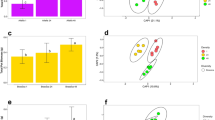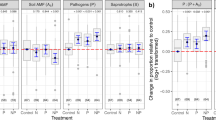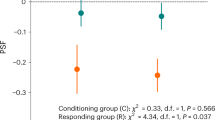Abstract
NEIGHBOURING plants usually influence each other's growth. These interactions are very important in determining the composition and structure of plant communities, but much remains to be discovered about the mechanisms by which plants influence each other. Often plants compete for requirements such as light and mineral nutrients. Some plants exude substances which are toxic to others1–3. Another possibility, as yet unexplored, is that interactions occur through changes in the microbial populations on the root surface or in the rhizosphere (the soil near the root surface). It is known that rhizosphere and root surface microorganisms can affect the plant's nutrient uptake and growth4,5, but up to now there has been no evidence on whether plant species which naturally grow together can influence each other's microbial populations. We present here such evidence for two species common in British lowland grassland, Lolium perenne L. (perennial ryegrass) and Plantago lanceolata L. (ribwort plantain, a dicotyledonous species).
This is a preview of subscription content, access via your institution
Access options
Subscribe to this journal
Receive 51 print issues and online access
$199.00 per year
only $3.90 per issue
Buy this article
- Purchase on Springer Link
- Instant access to full article PDF
Prices may be subject to local taxes which are calculated during checkout
Similar content being viewed by others
References
Muller, C. H., Vegetatio, 18, 348–57 (1969).
U.S. National Committee for the International Biological Program, Biochemical Interactions among Plants (National Academy of Sciences, Washington, D.C., 1971).
Whittaker, R. H., and Feeny, P. P., Science, 171, 757–70 (1971).
Barber, D. A., A. Rev. Pl. Phys., 19, 71–88 (1968).
Bowen, G. D., and Rovira, A. D., in Root Growth (edit. by Whittington, W. J.), 170–99 (Butterworths, London, 1969).
Newman, E. I., J. appl. Ecol., 3, 139–45 (1966).
Rovira, A. D., Newman, E. I., Bowen, H. J., and Campbell, R., Soil Biol. Biochem. (in the press).
Syme, J. R., and Bremner, P. M., J. appl. Ecol., 5, 659–74 (1968).
Marshall, D. R., and Jain, S. K., J. Ecol., 57, 251–70 (1969).
Harris, W., and Thomas, V. J., N.Z.J. agric. Res., 15, 19–32 (1972).
Author information
Authors and Affiliations
Additional information
The original article can be found online at https://doi.org/10.1038/251750d0
Rights and permissions
About this article
Cite this article
CHRISTIE, P., NEWMAN, E. & CAMPBELL, R. Grassland species can influence the abundance of microbes on each other's roots. Nature 250, 570–571 (1974). https://doi.org/10.1038/250570a0
Received:
Published:
Issue Date:
DOI: https://doi.org/10.1038/250570a0
This article is cited by
-
Baicalin Released from Scutellaria baicalensis Induces Autotoxicity and Promotes Soilborn Pathogens
Journal of Chemical Ecology (2010)
-
The impact of soil organism composition and activated carbon on grass-legume competition
Plant and Soil (2009)
-
Positive interactions among plants
The Botanical Review (1995)
-
Microbial abundance in the rhizosphere: A computer model
Plant and Soil (1977)
-
Effects of nutrient supply and competition from other species on root growth of Lolium perenne in soil
Plant and Soil (1976)
Comments
By submitting a comment you agree to abide by our Terms and Community Guidelines. If you find something abusive or that does not comply with our terms or guidelines please flag it as inappropriate.



